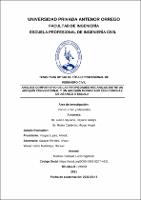| dc.contributor.advisor | Medina Carbajal, Lucio Sigifredo | |
| dc.contributor.author | Luna Usquiano, Dayane Gladys | |
| dc.contributor.author | Rubio Calderón, Miguel Ángel | |
| dc.creator | Luna Usquiano, Dayane Gladys | |
| dc.date.accessioned | 2022-08-15T12:51:06Z | |
| dc.date.available | 2022-08-15T12:51:06Z | |
| dc.date.issued | 2022 | |
| dc.identifier.uri | https://hdl.handle.net/20.500.12759/9316 | |
| dc.description.abstract | En el presente trabajo se analiza las propiedades mecánicas existentes de un
adoquín convencional y se realiza la comparación de estas propiedades entre un
adoquín que fue modificado con conchas de abanico. Se elaboraron adoquines
sustituyendo diferentes porcentajes (8%, 10% y/o 15%) de agregado por conchas
de abanico, de este modo buscamos que las propiedades mecánicas de este
adoquín modificado sean superiores y destaquen más por su tiempo de vida útil
que un adoquín convencional.
La metodología que se realizó, para la siguiente investigación es del tipo
experimental, puesto que mediante ensayos se evaluó los resultados obtenidos,
para esto primero denominamos a nuestros grupos de estudio en: Grupo de
control y Grupo experimental, en el cual se usó como agregado a cierto
porcentaje de conchas de abanico con relación al procedimiento de diseño del
adoquín modificado y con el diseño del adoquín convencional, debido a que la
concha de abanico posee un alto contenido de calcio, carbono y oxigeno CaCO3
siendo estos uno de los componentes principales del cemento, por lo tanto al
usarlo como agregado se espera obtener buenos resultados.
Se fabricó adoquines modificados cuyas dimensiones a escala 1/3 son de 6.67
centímetros para el largo, 3.33 centímetros para el ancho y 2.67 centímetros para
su altura, cuyo curado se realizó en los 7 días iniciales para posteriormente
realizar los correspondientes ensayos que solicita la norma E.070 (2020) que
consiste en ensayos de alabeo, variación dimensional, absorción y resistencia a la
compresión.
Los ensayos que se realizó a los adoquines con una sustitución de 15% de
concha de abanico se obtuvo una resistencia a la compresión la cual supero la
carga mínima que está establecido en la norma. En cuanto al resto de ensayos
que son de absorción, alabeo y variación dimensional se obtuvo resultados que
cumplen con lo establecido con la norma.
Por último, al grupo experimental o adoquines modificados con conchas de
abanico se les hizo una comparación con el grupo de control o adoquín
convencional tipo C, obteniendo resultados, con relación a la mínima resistencia
que está establecida en la norma. | es_PE |
| dc.description.abstract | In the present work, the comparison of the mechanical properties between a
conventional paver and a modified paver with fan shells is analyzed. Paving
stones were made by substituting different percentages (8%, 10% and / or 15%) of
aggregate for fan shells, in this way we seek that the mechanical properties of this
modified paving stone are superior and stand out more for its useful life than a
conventional paving stone.
The methodology that was carried out for the following research is of the
experimental type, since the results obtained were evaluated through tests, for this
we first called our study groups in: Control group and Experimental group, in which
it was used as an aggregate a certain percentage of fan shells in relation to the
modified paving stone design procedure and with the conventional paver design,
because the fan shell has a high content of calcium, carbon and oxygen CaCO3,
these being one of the main components of the cement, therefore when using it as
an aggregate it is expected to obtain good results.
Modified paving stones were manufactured whose 1/3 scale dimensions are
6.67 cm long, 3.33 cm wide and 2.67 cm high, whose curing was carried out in the
initial 7 days to later carry out the corresponding tests requested by the E.070
standard (2020) which consists of warping, dimensional variation, absorption and
compressive strength tests.
The tests carried out on the pavers with a 15% substitution of fan shell obtained
a resistance to compression which exceeded the minimum load established in the
standard. As for the rest of the tests that are of absorption, warping and
dimensional variation, results were obtained that comply with the provisions of the
standard.
Finally, a comparison was made to the experimental group or modified pavers
with fan shells with the control group or conventional type C pavers, obtaining
results in relation to the minimum resistance that is established in the standard | en_US |
| dc.description.uri | Tesis | es_PE |
| dc.format | application/pdf | es_PE |
| dc.language.iso | spa | es_PE |
| dc.publisher | Universidad Privada Antenor Orrego | es_PE |
| dc.relation.ispartofseries | T_CIVIL_2095 | |
| dc.rights | info:eu-repo/semantics/openAccess | es_PE |
| dc.rights.uri | https://creativecommons.org/licenses/by/4.0/ | es_PE |
| dc.source | Universidad Privada Antenor Orrego | es_PE |
| dc.source | Repositorio Institucional - UPAO | es_PE |
| dc.subject | Adoquín | es_PE |
| dc.subject | Conchas | es_PE |
| dc.title | Análisis comparativo de las propiedades mecánicas entre un adoquín convencional y un adoquín modificado con conchas de abanico a escala | es_PE |
| dc.type | info:eu-repo/semantics/bachelorThesis | es_PE |
| thesis.degree.level | Título Profesional | es_PE |
| thesis.degree.grantor | Universidad Privada Antenor Orrego. Facultad de Ingeniería | es_PE |
| thesis.degree.name | Ingeniero Civil | es_PE |
| thesis.degree.discipline | Ingeniería Civil | es_PE |
| dc.subject.ocde | https://purl.org/pe-repo/ocde/ford#2.01.00 | es_PE |
| renati.advisor.orcid | https://orcid.org/0000-0001-5207-4421 | es_PE |
| renati.author.dni | 76331481 | |
| renati.author.dni | 70479892 | |
| renati.advisor.dni | 40534510 | |
| renati.type | https://purl.org/pe-repo/renati/type#tesis | es_PE |
| renati.level | https://purl.org/pe-repo/renati/level#tituloProfesional | es_PE |
| renati.discipline | 732016 | es_PE |
| renati.juror | Vargas Lopez, Alfredo | |
| renati.juror | Salazar Perales, Alvaro | |
| renati.juror | Vertiz Malabrigo, Manuel | |
| dc.publisher.country | PE | es_PE |


